Have you ever had one of those mornings where your hair just won’t cooperate? I certainly have. Standing in front of the mirror, armed with various products and tools, yet somehow still ending up with a messy bun out of frustration. If this sounds familiar, you’re not alone in the daily struggle for manageable, healthy hair.
Women’s hair care can feel like navigating a complex maze, especially with countless products lining store shelves, each promising miraculous results. But what if achieving that healthy, enviable mane doesn’t require expensive salon treatments or complicated routines?
In this comprehensive guide, I’ll walk you through everything you need to know about caring for your tresses naturally, focusing on solutions that are gentle on your hair and the planet.
Understanding Your Hair: The Foundation of Proper Care
Before diving into products and routines, let’s talk about what makes your hair unique. Hair isn’t one-size-fits-all, and understanding your specific hair type is crucial for effective care.
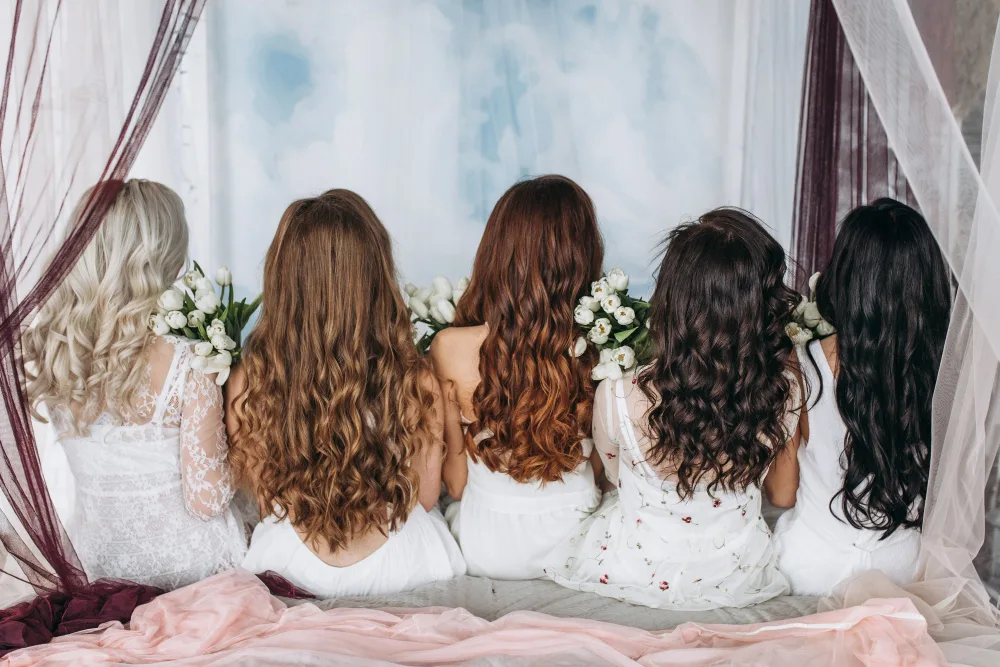
Identifying Your Hair Type
Hair typically falls into four main categories:
- Straight – Tends to be oily as sebum travels easily down the hair shaft
- Wavy – Can range from slight S-patterns to more defined waves
- Curly – Forms loose loops to tight spirals
- Coily/Kinky – Tightly coiled pattern with significant volume
Beyond these patterns, hair can also be:
- Fine (thin individual strands)
- Medium (average thickness)
- Coarse (thick individual strands)
And let’s not forget porosity (how well your hair absorbs moisture), which can be:
- Low (moisture resistant)
- Normal (balanced absorption)
- High (quickly absorbs moisture but loses it just as fast)
“Understanding your unique hair type is like having a roadmap for your hair care journey,” explains celebrity hairstylist Maria Rodriguez. “It takes the guesswork out of product selection and helps you develop a routine that actually works.”
The Clean Hair Revolution: Why Chemical-Free Matters
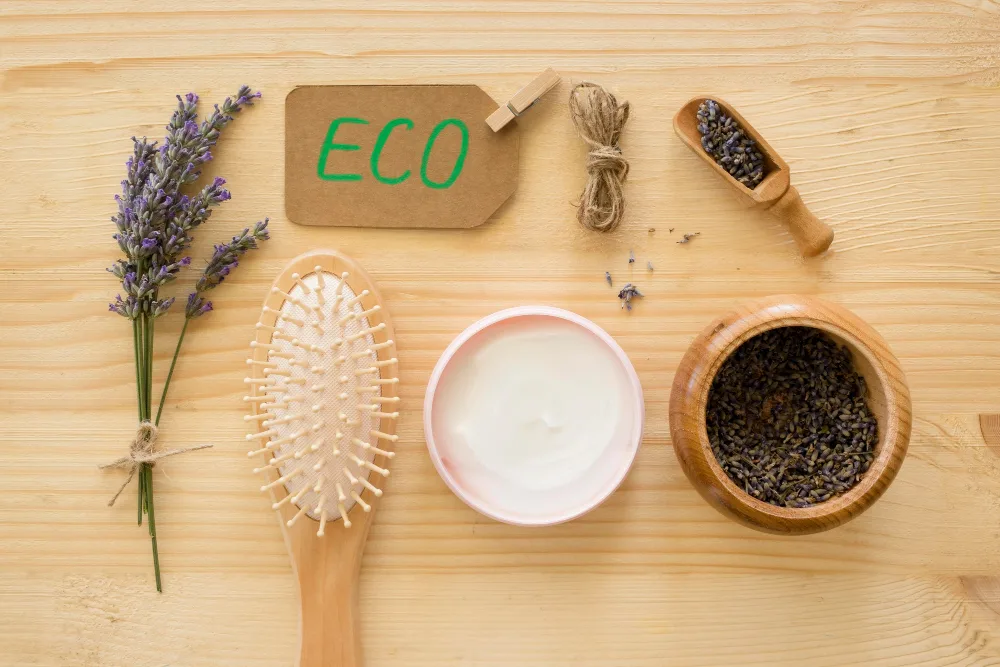
When I first started paying attention to ingredient lists, I was shocked at what I found lurking in my favorite shampoos. Sulfates, parabens, phthalates, and synthetic fragrances—these chemicals might create satisfying lather or appealing scents, but they often do more harm than good.
The Problem with Conventional Hair Products
Traditional hair care products frequently contain:
- Sulfates (like sodium lauryl sulfate): Strip natural oils, causing dryness
- Parabens: Preservatives linked to hormone disruption
- Silicones: Create artificial smoothness while preventing moisture absorption
- Synthetic fragrances: Potential irritants and allergens
These ingredients provide immediate gratification—that squeaky clean feeling or temporary shine—but can lead to long-term damage, including dryness, breakage, scalp irritation, and even hair loss.
Benefits of Going Natural
Switching to chemical-free hair care offers numerous advantages:
- Gentler cleansing that preserves natural oils
- Improved scalp health with fewer irritants
- Better long-term hair strength and integrity
- Reduced environmental impact from safer ingredients
- Less exposure to potentially harmful chemicals
As someone who made the switch three years ago, I can attest to the difference. My once frizzy, perpetually dry hair has transformed into manageable, healthier locks that actually hold styles better than before.
Building Your Natural Hair Care Routine
Creating an effective hair care routine isn’t about using dozens of products. Instead, focus on these essential steps with quality, natural alternatives.
1. Cleansing: Finding Your Perfect Natural Shampoo
How often should women wash their hair? There’s no universal answer—it depends on your hair type, lifestyle, and personal preference. Generally:
- Oily hair: May need washing every 1-2 days
- Normal hair: Typically benefits from washing every 2-3 days
- Dry or curly hair: Often thrives with washing just 1-2 times per week
The right sulfate-free shampoo can transform your hair care experience. Unlike conventional shampoos that create abundant foam through harsh detergents, natural options cleanse without stripping away essential moisture.
Top Natural Shampoo Picks:
- Shea Moisture Raw Shea Butter Shampoo: Perfect for dry, damaged hair with its rich blend of shea butter and argan oil
- Innersense Organic Beauty Pure Harmony Shampoo: An excellent choice for sensitive scalps with its gentle formula
- Ethique Eco-Friendly Solid Shampoo Bar: Ideal for eco-conscious consumers seeking to reduce plastic waste
Pro tip: When transitioning to natural shampoos, your hair might go through an adjustment period as it rebalances oil production. Be patient—the results are worth it!
2. Conditioning: Nourishment Your Hair Craves
Choosing the right conditioner for your hair type is crucial for maintaining moisture balance and manageability. Here’s how to match your conditioner to your needs:
- Fine hair: Lightweight, volumizing conditioners that won’t weigh hair down
- Medium to thick hair: Moisturizing formulas with natural oils
- Curly or coily hair: Rich, deeply hydrating conditioners with butter and proteins
- Damaged hair: Protein-rich reconstructing conditioners
Natural Conditioner Standouts:
- Briogeo Don’t Despair, Repair! Mask: A deep conditioning treatment that restores severely damaged hair
- Avalon Organics Biotin B-Complex Thickening Conditioner: Great for adding volume to fine hair
- Desert Essence Coconut Conditioner: Provides excellent moisture for dry, brittle strands
3. Treatment: Targeted Solutions for Specific Concerns
Whether you’re battling frizz, seeking growth, or wanting to strengthen fragile strands, natural treatments offer effective solutions.
For Frizzy Hair Control:
Humidity can wreak havoc on even the most carefully styled hair. Natural anti-frizz solutions include:
- Argan oil: Apply a few drops to damp hair before styling
- Flaxseed gel: A homemade option that provides hold without crunch
- Leave-in conditioners: Look for formulas with natural humectants
“One of my favorite tricks for frizzy hair is making a DIY flaxseed gel,” shares natural hair blogger Tina Johnson. “Just one tablespoon of flaxseeds boiled in a cup of water creates an amazing gel that controls frizz without chemicals.”
For Hair Growth:
Many women experience thinning hair or desire more length. Natural growth-promoting options include:
- Scalp massages with essential oils: Rosemary, peppermint, and lavender oils can stimulate circulation
- John Masters Organics Scalp Serum: Contains natural ingredients that support a healthy environment for growth
- Internal support: Ensure adequate protein, biotin, and other nutrients through diet
For Split Ends and Breakage:
While nothing truly “repairs” split ends (trimming is the only real solution), these natural treatments can help prevent further damage:
- Regular trims: Schedule cuts every 8-12 weeks
- Protein treatments: Look for products with plant-based proteins like quinoa or rice
- Moisture balance: Use leave-in conditioners and oil-based serums on ends
DIY Natural Hair Treatments: Spa Day at Home
![Insert image of homemade hair mask ingredients here]
Some of the most effective hair treatments come straight from your kitchen. Here are three simple recipes you can make at home:
Deep Conditioning Avocado Mask
Perfect for dry, damaged hair
Ingredients:
- 1 ripe avocado
- 2 tablespoons olive oil
- 1 tablespoon honey
Directions:
- Mash avocado until smooth
- Mix in olive oil and honey
- Apply to damp hair, focusing on ends
- Cover with a shower cap for 30 minutes
- Rinse thoroughly and shampoo as usual
Aloe Vera Scalp Treatment
Ideal for itchy, irritated scalps
Ingredients:
- 3 tablespoons fresh aloe vera gel
- 5 drops tea tree essential oil
- 1 teaspoon apple cider vinegar
Directions:
- Mix all ingredients in a small bowl
- Apply directly to scalp with fingertips
- Massage gently for 5 minutes
- Leave on for 30 minutes before shampooing
Rice Water Rinse
Traditional treatment for strength and shine
Ingredients:
- 1/2 cup uncooked rice
- 2 cups water
Directions:
- Rinse rice thoroughly
- Soak in water for 30 minutes
- Strain rice, keeping the water
- After shampooing, pour rice water over hair
- Massage into scalp and through lengths
- Leave on for 5-10 minutes before rinsing
Protecting Your Hair: Prevention is Better Than Cure
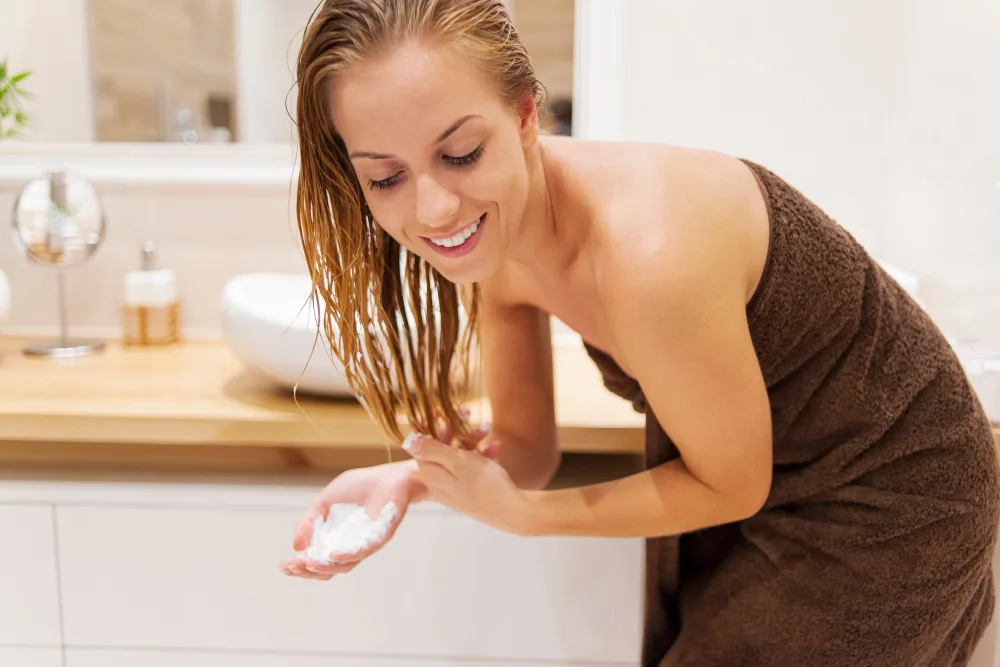
Heat Styling: Minimizing Damage
Let’s be honest—many of us aren’t ready to give up our blow dryers and curling irons completely. The good news is you can minimize damage with these practices:
- Always use heat protectant: Apply NatureLab Tokyo Perfect Smooth Blowout Lotion or a similar natural heat protectant before styling
- Lower the temperature: Most tools work effectively at medium heat settings
- Limit frequency: Try to incorporate air-drying and heatless styling methods
- Invest in quality tools: Ceramic and tourmaline options distribute heat more evenly
Environmental Protection
Your hair faces daily aggressors beyond styling tools:
- UV damage: Wear hats or use products with natural UV filters like red raspberry seed oil
- Chlorine and salt water: Wet hair with clean water before swimming to limit absorption
- Pollution: Rinse hair thoroughly at the end of each day in urban environments
Nighttime Care
What you do before bed can significantly impact hair health:
- Silk or satin pillowcases: Reduce friction and prevent moisture loss
- Loose protective styles: Prevent breakage from tossing and turning
- Night serum: Apply a light natural oil to ends for overnight protection
Special Considerations: Addressing Common Concerns
Dandruff and Scalp Issues
Dealing with dandruff in women’s hair requires understanding the root cause. Natural approaches include:
- Tea tree oil treatments: This natural antifungal can help with many types of dandruff
- Apple cider vinegar rinses: Help balance scalp pH and fight yeast
- Lush Soak And Float Solid Shampoo Bar: Contains cade oil to soothe irritated scalps
Color-Treated Hair
Natural hair care extends to colored locks too:
- Wait 48-72 hours after coloring before washing
- Use color-safe, sulfate-free shampoos
- Incorporate deep conditioning treatments weekly
- Protect from sun exposure which can fade color
Pregnancy and Postpartum Changes
Hormonal fluctuations during and after pregnancy can dramatically affect hair:
- Pregnancy: Often brings thicker, fuller hair due to prolonged growth phase
- Postpartum: Temporary shedding is normal as hair cycles normalize
- Gentle care: Focus on nourishing products during these transition periods
Expert Insights: The Science Behind Healthy Hair
To gain deeper insights into natural hair care approaches, I spoke with Dr. Jennifer Lee, a dermatologist specializing in scalp and hair health.
The scalp is an extension of your facial skin and deserves the same careful attention. Many hair issues actually begin with scalp imbalances, which is why gentle, non-stripping cleansers are so important.
Dr. Jennifer LeeDr. Lee recommends a holistic approach that considers:
- Internal factors: Nutrition, hydration, and stress management
- External care: Gentle products without harsh chemicals
- Mechanical treatment: Minimal heat, gentle brushing, and protective styling
Top Chemical-Free Products for Every Hair Concern
Based on expert recommendations and customer reviews, here’s a comprehensive guide to the best natural hair care products for specific needs:
For Dry, Damaged Hair
- Shea Moisture Raw Shea Butter Shampoo: Deeply moisturizing with shea butter and argan oil
- Briogeo Don’t Despair, Repair! Mask: Intensive weekly treatment with natural oils and B-vitamins
- Moroccanoil Treatment Original: Argan oil-based serum that transforms dry, lifeless hair
For Sensitive Scalps
- Innersense Organic Beauty Pure Harmony Shampoo: Gentle, sulfate-free formula for daily cleansing
- Giovanni Tea Tree Triple Treat Shampoo: Soothes irritation with tea tree and peppermint oils
- Weleda Oat Replenishing Treatment: Calms inflammation with oat extract
For Frizz Control
- Love Beauty And Planet Argan Oil Shampoo: Smooths hair with ethically sourced argan oil
- NatureLab Tokyo Perfect Smooth Blowout Lotion: Natural heat protectant that also fights frizz
- Kinky-Curly Knot Today Leave-In Detangler: Lightweight formula that tames frizz without heaviness
For Volume and Thinning Concerns
- Avalon Organics Biotin B-Complex Thickening Shampoo: Adds volume with biotin and saw palmetto
- John Masters Organics Scalp Serum: Stimulates the scalp to support healthy growth
- Yarok Feed Your Ends Leave-In Conditioner: Adds weightless moisture and protection
Making the Switch: Your Transition Plan
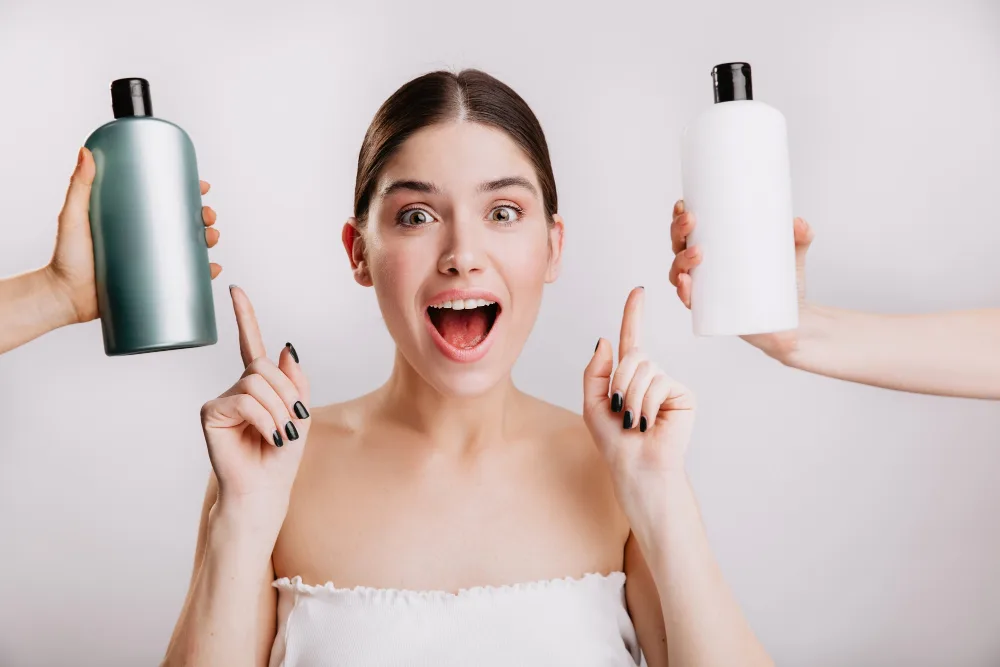
Switching to natural hair care doesn’t have to happen overnight. Here’s a gentle transition plan:
Week 1-2: Audit Your Current Products
- Read ingredient lists
- Identify problematic chemicals
- Research natural alternatives
Week 3-4: Begin Replacing Products
- Start with a gentle, sulfate-free shampoo
- Add a natural conditioner
- Keep using your other products temporarily
Week 5-6: Experiment With Treatments
- Try a DIY mask
- Add a natural oil serum
- Notice how your hair responds
Week 7-8: Complete Your Routine
- Replace remaining conventional products
- Establish a sustainable washing schedule
- Document changes in hair health
“The adjustment period when switching to natural products can last 2-4 weeks,” notes clean beauty advocate Sarah Miller. “During this time, your scalp recalibrates oil production, and your hair detoxes from silicone buildup. Patience during this phase pays off with healthier hair long-term.”
The Environmental Impact: Beauty Beyond Yourself
Choosing natural hair care isn’t just better for your locks—it’s better for the planet too:
- Reduced chemical runoff into water systems
- Less plastic waste with options like shampoo bars and recyclable packaging
- Support for sustainable ingredient sourcing
- Cruelty-free testing practices
Brands like Ethique with their zero-waste shampoo bars and Aveda with their commitment to sustainable sourcing demonstrate that effective hair care can coexist with environmental responsibility.
Conclusion: Your Hair Deserves Natural Care
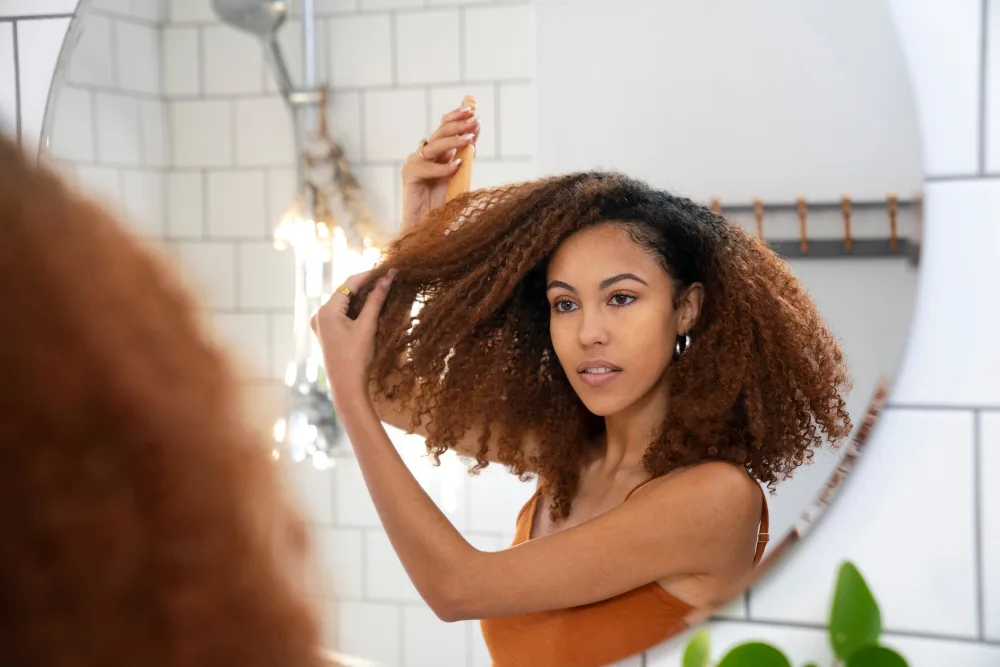
Beautiful, healthy hair doesn’t require harsh chemicals or complicated routines. By understanding your unique hair type, choosing gentle products, and establishing consistent care practices, you can achieve the hair of your dreams while staying true to natural principles.
Remember that patience is key—natural hair care is about long-term health rather than quick fixes. Your hair didn’t develop issues overnight, and it won’t heal overnight either. Give your new routine at least a month before assessing results.
I’d love to hear about your experiences with natural hair care! What chemical-free products have transformed your hair? Share your success stories in the comments below, or tag us in your before-and-after photos on social media.
Ready to take the first step toward healthier hair? Start by replacing just one conventional product with a natural alternative this week. Your hair—and the planet—will thank you.
This article was written by a hair care enthusiast with a vast experience in natural beauty approaches. While the information provided is based on research and expert opinions, individual results may vary. Always patch test new products and consult with a dermatologist for persistent hair or scalp concerns.




